1 Aesthetic Strategies of the Formidable
Matthew Lopez
This collection of essays is an investigation into the aesthetic strategies deployed in various fields of technology. Specifically, the project examines a militarized object, technological spaces, and systems of perception.
1 Aesthetic Strategies of the Formidable
Matthew Lopez
Photo by the author.
For better or worse, military development is largely responsible for some of mankind’s greatest technological achievements. While instruments of warfare are commonly associated with power, destruction, death and intimidation, often these militarized objects can elicit an aesthetic response. Lockheed Martin’s F-35 Lightning II is a highly engineered combat aircraft designed to perform complex ground attacks and defense missions for the United States Air Force, Marine Corps, and Navy. Although the engineering of this machine is paramount to its performance, one might begin to speculate whether there is aesthetic intent in something so visually striking. Perhaps the best way to answer this question would be to consider modes of architectural analysis and thought to a new domain in order to reveal its aesthetic strategies.
An Act of Close Reading
The project of close reading is one that assumes there is content. It is to take something that has a seemingly clear conclusion and to unravel it and make visible its complexities. The only reason to perform a close reading of a militarized object like the F-35 is to make the claim that these are not just efficiently engineered objects. Instead, these are inherently aesthetic objects operating within a culture that surrenders attention to them. But like all acts of close reading, what was once so clear is all the sudden unclear. One might assume that any attempt to extract an aesthetic strategy would be rather straightforward; let’s build the fastest and highest performing war machine possible and call it a day. It’s a fighter jet, not a beauty pageant. Instead, through this act of close reading, the object reveals itself as an embodiment of the complexities of society and culture in general.
In 1996 the largest acquisition program in the history of the Department of Defense (DoD) was announced and the Joint Strike Fighter (JSF) program began. The JSF was created to replace numerous aircraft as well as develop a common fighter that would succeed existing types. The U.S. military desired a low-cost multi- role fighter to serve the Air Force, Navy, and Marine Corps. A secret competition between Lockheed Martin and Boeing began when the two companies were awarded a four-year design development contract. Both would produce a ‘concept demonstration aircraft’ capable of exceptional combat prowess, carrier-approach handling, and short takeoff - vertical landing (STOVL) capabilities. This meant the plane would need to shift to and from hovering in mid-flight. Ultimately, the winner would receive a $200 billion defense contract to develop what could potentially be the last manned jet fighter for the U.S. Military and its allies. Technological objects like the F-35 have profound effects on how we perceive a nation and how its prestige is expressed and communicated via its war apparatus. Here we will identify and isolate an aesthetic strategy operating through our engineered modalities.

[Fig.1] Two F-22A Raptor in column flight. [U.S. Air Force photo by TSgt Ben Bloker]
The Strategy of Casual Adaptation
At the time of the competition, the current gold standard of American fighters was the F-22 Raptor, also designed by Lockheed Martin. [Fig.1] It was expensive, and not the all in one fighter the JSF required. The Raptor provided a wealth of proven design ideas including its radical new shape which was optimized primarily for stealth. The F-22 Raptor’s geometry is designed to give it an extremely low profile, making it nearly invisible to oncoming aircraft using high-frequency fighter aircraft radar. The basic principle of stealth technology is to make an airplane invisible to the enemy. For this to work effectively, an aircraft’s shape needs to deflect incoming radio waves away from the enemy radar rather than towards it. To further obscure the warplane’s visibility, an aircraft is covered in materials that absorb radar signals. This reduces its visibility on a radar screen. In the development of the F-35, Lockheed Martin decided not to completely redesign the plane, but to build on the previous stealthy shell of its successful F-22 in what can only be considered an act of wartime Casual Adaptation.
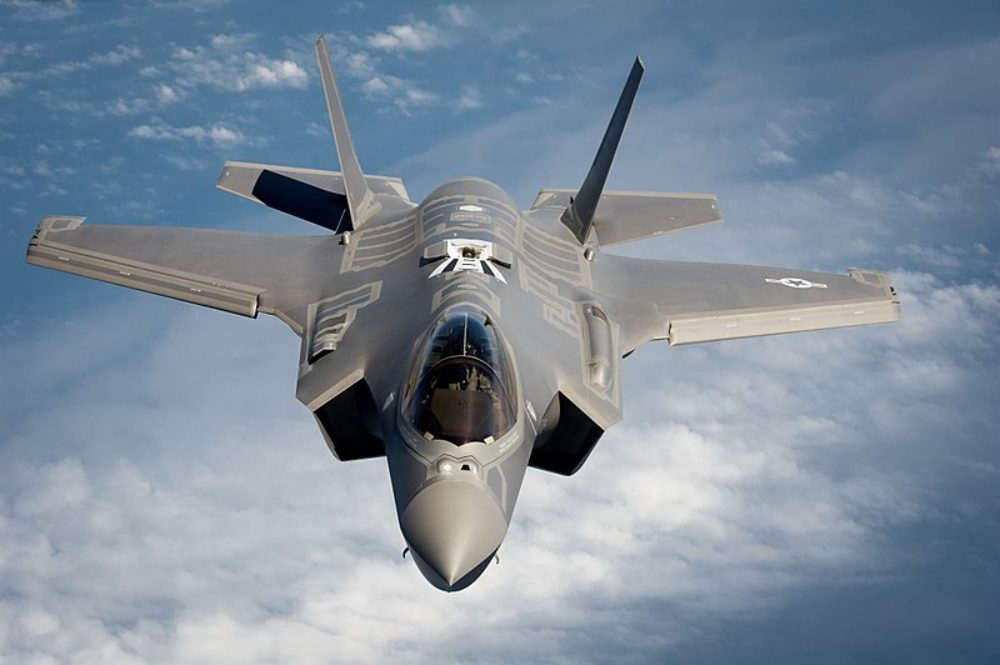
[Fig.2] F-35A Lightning II aircraft. This image is a work of a U.S. military or Department of Defense employee, taken or made as part of that person's official duties. As a work of the U.S. federal government, the image is in the public domain in the United States.
Experimental composers in the 1940’s began exploring techniques that involved using recorded sounds as raw material. This particular style of composition came to be known as Musique Concrète. It was an attempt to create new forms of classical composition by utilizing and reinterpreting familiar sounds to create an original work. Decades later, this technique is now referred to as sampling and has since been adopted by several musical genres. When the idea of sampling permeated throughout popular culture, its legitimacy as a creative output came into question. But if one sets this question of authenticity aside, we can instead prioritize its ability to warp the familiar. One might argue that Lockheed took a rather conservative approach in designing the F-35. [Fig.2] Instead of starting entirely from scratch, Lockheed used the F-22 as raw material. Its performance capability in air to air combat relies on its aerodynamic shape that is as visually striking as its capabilities. The strategy became one of Casual Adaptation; to modify a series of cross-sectional profiles that would accommodate the hardware needed to meet specific performance criteria.
In its mediated and classified state, the F-35 is only knowable through its name, its photographs, and the limited documentation offered to us by its creators. In the early twentieth century, Sigmund Freud wrote about the physiological concept of the uncanny. The uncanny breaks up any comfort of knowing what is immediately familiar leaving us justifiably flustered. Upon close reading, the F-35 is nothing more than a sampled version of its ancestor. It is both old and new; cautiously occupying the territory of the uncanny. What is useful to us is considering the territory the plane occupies and speculating on how we can embed similar aesthetic strategies to our design processes in hopes to produce a similar reaction. Through close reading we are able to examine the gap between the familiar and the uncanny and arrive at a serviceable methodology. In this case, the strategy of Casual Adaptation.
2 Techno Aesthetics
Garet Ammerman
Techno Aesthetics includes both places of power and places of high technology. Unlike high tech architecture, structural expressionism or machine architecture, this term does not describe an architectural style, but rather imagery of increasingly more influential fringe typologies. This categorization of spaces are typically devoted to protecting a single highly technological concrete object, as in the ULA launch site at Vandenberg Air Force Base or serve as an apparatus for extensive operations, as in the VLA Radio Astronomy Observatory. The term Places of Power is derived from John Sexton in Places of Power,1996
Data, information and electricity are abstract, but become a source of aesthesis when mediated by an adequate instrument that enables human perception. The complexity of the mediator allows partial access to an intangible commodity as part of the overall aesthetics of technology. We can not fully access the technology itself, it can only be understood through quantitative means and the physical materiality of the apparatus. The aesthetics of technology requires specific reasoning. To the visitor, it must be highly technological because it appears that way, or for users and especially the designers of the space, it must look highly technological first and therefore it will be.
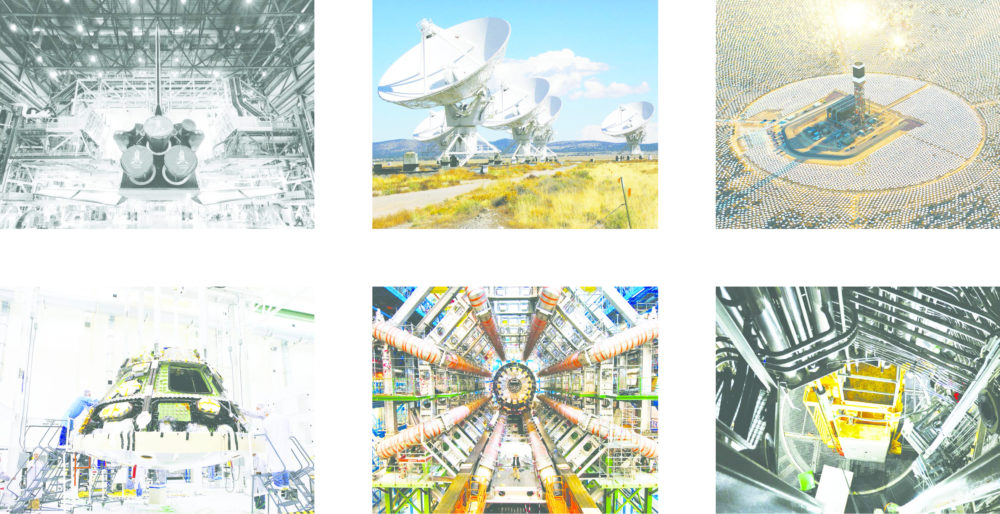
Tours of JPL give access to only a few rooms, including the highly published “big white room” where JPL employees are dressed in white bunny suits. This room is a mix of Ascetic and Schizo Tech aesthetics, a spotless white room with scattered Mars Rover objects and very low tech objects.
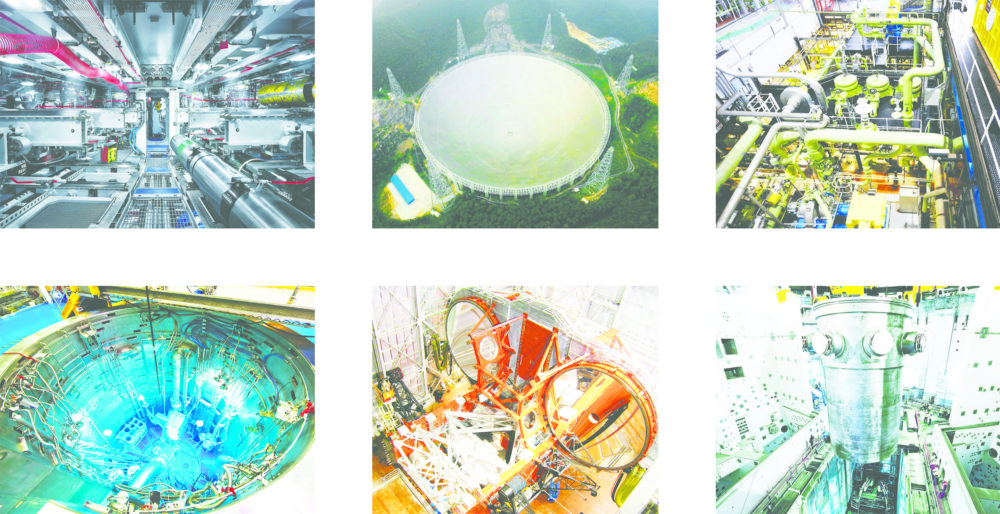
Arrays of technological objects present an aesthetics of much more far reaching power than a closed space. Understanding the functionality of the objects produces an even more dynamic sensibility to their existence. This set of radio satellites has an intense semantic power.
Unlike the true associations in the arrays of identical solar energy capturing mirrors in the desert, the LHC at Cern operates through compatible associations of the individual pieces. Each strand weaving perfectly through all the others. The LHC has a Technicolor Science Aesthetic, displaying many bright colors.
The Techno-Aesthetics of these “places of power” require a simultaneous absorption of the materiality, scale and complexity of the physical objects they are designed for. The technical functionalities reach beyond the locations of the buildings themselves to include military, space exploration, energy and communications.
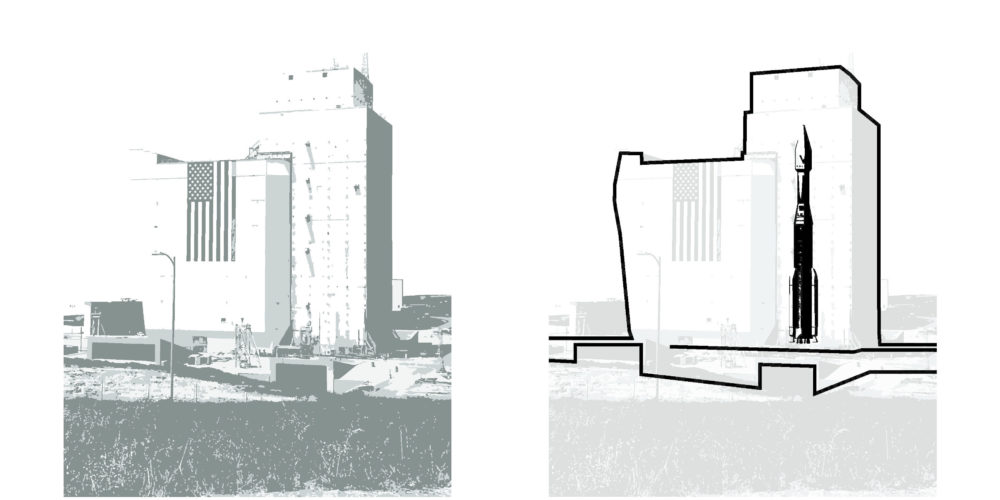
3 Aesthetics in War and Art
Pierce Myers
Every action, including uses of force, must be “wrapped in a bodyguard of information.”
-General David Petraeus, the Counterinsurgency Field Manual
It’s literally as if you could disappear into it.
-Anish Kapoor
Strategies used in warfare and art are similar in more cases that we frequently consider. While each of these fields is infinitely multiple within itself, and while the two fields often pursue diametrically opposed ends, there are strategies afforded by emerging technical capabilities that are deployed consistently in both. The particular strategy that we observe exists in cases across the last 100 years, that strategy being the development of aesthetic defamiliarization.
Around 1917 Viktor Shklovsky developed his canonical definition of art as a technique of defamiliarizing the object, to make forms difficult to apprehend or to increase the amount of time required to develop an accurate perception of the thing in question. For Shklovsky, a Russian literary and art critic, the process of perceiving was an aesthetic end in itself and was be extended as long possible. He’s known for remarking that successful art is a way of experiencing the artfulness of an object, and that the object itself is not important. His seminal text Art as Technique explores devices such as non-human narrators to modulate a reading of the content of a story, to deautomate or impede a straightforward perception of a form. We note that 1917 is the year in which Duchamp submitted a urinal for display in a prominent New York exhibition, a signalling of the desire to deautomate the process of categorical determination of the limits of art.
Equally canonical, but in the realm of warfare is a strategy contemporary to Shklovsky’s called dazzle camouflage. This was a technique developed by Norman Wilkinson, a British maritime painter and poster designer. Depicted below, this technique involves the painting of warships with patterns which effectively inhibit an enemy’s ability to create an accurate model of the orientation, size, and motion of a sea craft. Being a pre-radar strategy, dazzle camouflage was an aesthetic application formatted against the periscopically augmented human eye. Serving in a naval force during the First World War, Wilkinson arrived at this idea in the Spring of 1917 as the Royal Navy was pummeled by German U-boats.
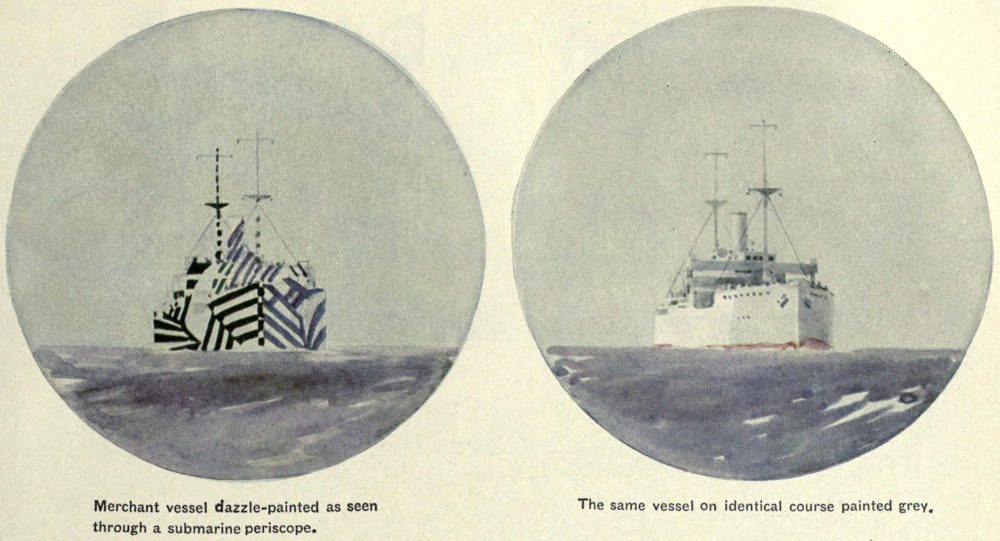
Vessel with and without dazzle camouflage, as seen through a periscope.
As sensing technologies progress, augmenting and extending the field of possible perceptions calls for the elaboration of constantly progressing counterstrategies for defamiliarizing objects in a field. The retired Israeli General Shimon Naveh, a self-proclaimed Deleuzian, articulates a desire to deprive the enemy of the ability to give form to his forces. Discoursing on the counterinsurgency tactics of the post-9/11 Israeli-Palestine conflict, Naveh artfully contorts post-structuralist tenets into the formulation of a problem called “formalizing the subversive”. On planes of technically augmented aesthetic sensing, as with the military uses of remote sensing to build tactical models in software, the aim is to create de-noised models of the Other within a multi-layered urban space while remaining effectively unmodelable yourself. War becomes nothing more formalizing the subversive, giving the Other form so that belligerent operations can proceed without surprises. Aesthetics in this case describes the realm of that which can be made available to sense perception, similar to Ranciere’s formulation, whether by a human or some other machine. Aesthetics become to criteria for developing formal models.
The sharp decline in the success of formally articulated ground forces in the post-Kuwait era is attributable in large part to the capacities of powerful computers which can host and synthesize spatialized models of a war space, models which are fed information by satellites, aircraft, ground ops and other extremity sensors which feed that model. The disintegrating distinction between soldiers and civilians is an instance of a counter-measure formatted against this kind of aerial remote sensing. As a result, the militaries of developed nations increasingly develop new parsing methods which seek to model this disintegrating distinction in the post-9/11 era, often resulting in Quixotic failure. By way of example, a parsing system called the Human Terrain System (HTS) was developed by the United States in 2005 in the height of the counterinsurgency zeitgeist. The HTS brought in groups of anthropologists, linguists, and sociologists to develop actionable models of threat networks in Iraq and Afghanistan through direct interface with a community in question. “How to model a threat that no longer formally articulates itself?”
The motivation of resisting ones incorporation into the Other’s tactical model always manifests in new ways. Agents in protracted territorial disputes continually format and reformat their visibility against the sensing capabilities of the Other. The rule remains however, that within any system involving territorial advancement, a novel aesthetic regime is always integral.
The late-2016, early-2017 legal dispute between Anish Kapoor and Stuart Semple over VantaBlack paint serves as a contemporary analog. VantaBlack is a paint made of vertically aligned carbon nano-tubes which absorbs 99.97% of all light which contacts it. Kapoor managed to secure an exclusive license to this proprietary substance, bullying lower profile artists over access. He eventually filed a lawsuit against Stuart Semple, who in response to Kapoor produced his own version of the paint, called Black 2.0. In February of 2017 Kapoor officially won exclusive rights to the material, securing a monopoly over the ability to sequester light from a visual environment at a greater rate than anyone else, drawing intense criticism from the art community. Kapoor proceeded to purchase Semple’s pink variety, called The World’s Pinkest Pink, dipped his middle finger in it, and posted the photo below on Instagram before removing it shortly thereafter. Still relatively secret, we are helped to imagine how Kapoor might utilize this chromopolitical Vantablack by his quote on the matter “It’s literally as if you could disappear into it”.

Anish Kapoor dips his middle finger into Stuart Semple's 'Pink' pigment, posts image to Instagram.
At the edge of the field of spatial immersion, artists extract affect from subjects through strategies which also have bellicose or geopolitical applications as well. Vantablack was a paint originally debuted to the public in 2014 at Farnborough Airshow by a group called Surrey Nanosystems. This group develops chromo-systems, microfilms, and computational substrates, most of which are developed for military application. The original aim of the Vantablack project was “to develop super-black coatings to enhance the performance of sensitive electro-optical imaging systems in a satellite application”, to effectively suck light from the interior chambers of hyper-light sensitive cameras and sensors to enhance the remote sensing capabilities of satellites and other airborne craft. These are the craft which support the massive security and surveillance apparatus discussed above. When Kapoor refers to how he might create a work into which subjects can disappear he also makes implicit reference to the optical apprehension of agents in a contested urban space by British or US surveillance.
In conclusion, aesthetics are determinable according to Ranciere as “the system of a priori forms determining what presents itself as sense experience. It is a delimitation of spaces and times, of the visible and the invisible, of speech and noise, that simultaneously determines the place and the stakes of politics as a form of experience.” Here we extend this formulation by associating aesthetics directly to modeling. Ranciere’s aesthetics are the material which feeds a system of modeling. The system of modeling then automatically generates its countermeasure: the aesthetic strategy of defamiliarization.